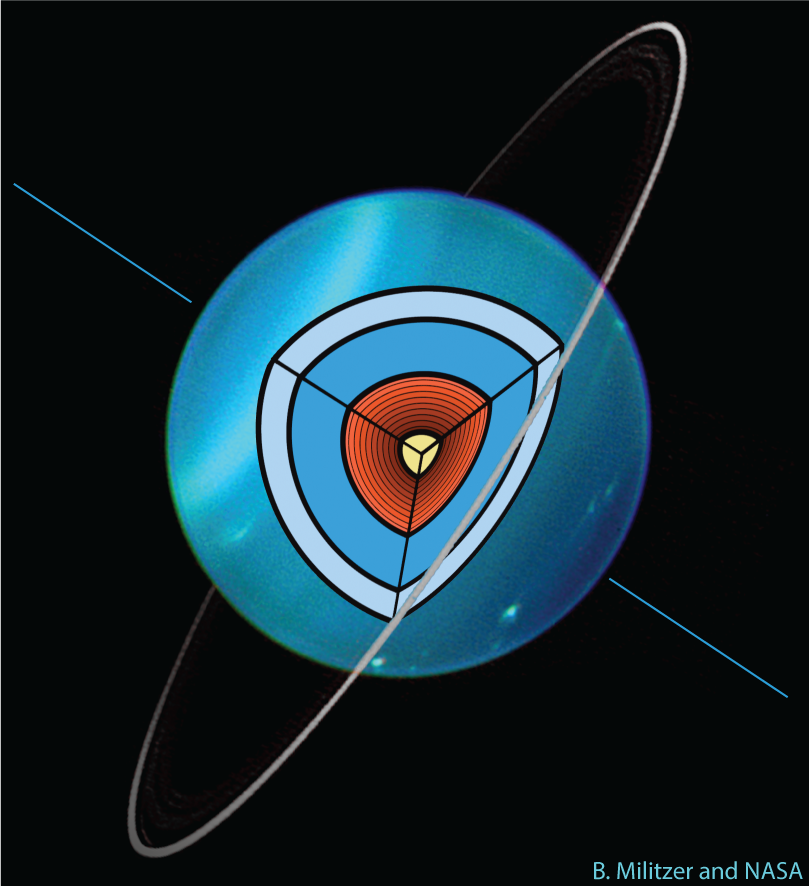New models using Voyager 2 data from the 1980s show that separate layers in the planets’ mantles could be creating disordered magnetic fields.

This illustration shows the interior structure of Uranus with four layers: hydrogen (light blue), water (dark blue), hydrocarbons (red), and a rocky core (yellow). Uranus has a disordered magnetic field that originates from its water layer. Credit: B. Militzer and NASA
In 1986 and 1989, Voyager 2 made the final two stops on its grand tour of the outer solar system when it swept by Uranus and Neptune, respectively. Now, nearly 40 years later, the archive of data the craft collected is still returning unexpected results.
In a paper published today in PNAS, astronomer Burkhard Militzer of the University of California, Berkeley wanted to explore why Voyager 2 data show something unexpected: The magnetic fields of both planets, which are not that far apart in mass, are not dipolar. Earth, Jupiter, and Saturn all have dipolar magnetic fields, meaning they have a north and south pole — the type of configuration we’re obviously used to.
But Uranus and Neptune don’t. Instead, their magnetic fields are more of a jumbled maze than an ordered set of lines.
Oil and water
Earth’s spinning, partly molten core generates much of our planet’s magnetic field. But on Uranus and Neptune, that’s not the case. Instead, their magnetic field is generated in the mantle.
And Militzer discovered that the composition of the planets’ upper mantle is much different than that farther below. The planets are both considered “ice giants” rather than gas giants because beneath their atmosphere is an icy mantle, composed of compressed water, methane, and ammonia, below which is the planet’s rocky core.
Within the mantle, Militzer says, he discovered that the layers of water, methane, and ammonia stratify — like oil and water. “They stay separated into an oxygen range layer and the carbon nitrogenous layer and at that moment, I knew that’s probably a good answer to pursue and that’s how I started,” Militzer tells Astronomy.
He made this discovery through modeling the known compositions of the ice giants — a tough proposition given that they’ve only been visited once. Militzer says he relied on a range of previous studies that used Voyager data to build a simulation of the interior of both planets.
He found that the magnetic field is generated in the watery layer, while the layers containing carbon, nitrogen, and hydrogen don’t produce magnetism. And it’s because of this behavior that the magnetic fields of the ice giants are more disordered.
Militzer’s simulations took all the chemicals involved in these interactions and determined how they would act in each layer. He found that the water layer experiences convection, which may drive the planets’ magnetic fields. The deeper layers essentially don’t form a lot of chemical bonds, or form them mostly with each other, which doesn’t really allow for convection in the simulation.
Far-reaching implications
The only way to truly test the results would be through in situ measurements. There are numerous proposals for spacecraft to visit both worlds, and the furthest along is a mission concept called the Uranus Orbiter and Probe. The mission would drop a Galileo-like probe into the atmosphere of Uranus to take measurements. And the right suite of instruments could provide the data Militzer and others confirmation of whether a convecting water layer is driving the disordered magnetic field. However, even that mission is still in the development phase, with a green light far from a sure thing.
Nonetheless, the implications of this find extend far beyond our own solar system. Neptune- and Uranus-type exoplanets are more abundant than Jupiter-like planets, and worlds called mini-Neptunes, with masses between that of Earth and Neptune, are even more abundant than those. So, by understanding Neptune and Uranus more deeply, we may be able to understand more about those other planets as well, which helps us to build a more complete view of the planets that populate our galaxy.

